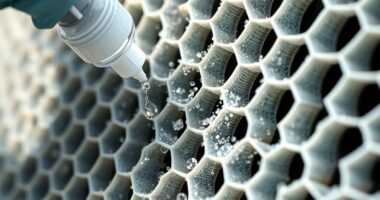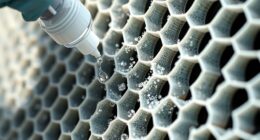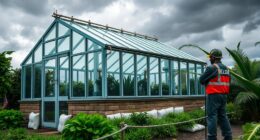To keep your greenhouse tools in top shape, regularly sharpen and sanitize them. Use the right sharpening tools like stones or files, keeping blades smooth and at consistent angles, especially after noticing resistance or uneven cuts. After each use, disinfect tools with alcohol, bleach, or horticultural disinfectants, soaking if necessary. This process prevents disease spread, reduces pest risks, and promotes healthier plant growth. Continuing will guide you through simple techniques for effective tool upkeep.
Key Takeaways
- Regularly sharpen tools using appropriate stones or grinders to maintain clean, precise cuts that promote healthy plant growth.
- Sharpen blades at consistent angles and smooth out nicks or burrs for optimal efficiency.
- Disinfect tools after each use with alcohol, bleach, or horticultural disinfectants to prevent disease spread.
- Soak heavily contaminated tools for 10-15 minutes in disinfectant, then dry thoroughly to prevent rust.
- Incorporate routine sharpening and sanitizing into gardening practices to extend tool lifespan and ensure a healthier greenhouse environment.

Maintaining your greenhouse tools through proper sharpening and sanitizing is crucial for healthy plant growth and efficient gardening. When you focus on tool maintenance, you not only extend the lifespan of your equipment but also reduce the risk of spreading pests and diseases. Sharp tools make cleaner cuts, which helps plants heal faster and minimizes the chance of infections. Sanitizing tools between uses further prevents the transfer of harmful microorganisms, pests, and fungi that can compromise your crops. By integrating regular sharpening and sanitizing routines into your gardening practices, you create a healthier environment for your plants and improve overall productivity.
Start with sharpening your tools regularly. Dull blades require more force to cut, which can damage plant tissues and create openings for pests and diseases. Use a sharpening stone, file, or grinder appropriate for the tool’s material and design. For pruning shears, it’s best to sharpen the blades at a consistent angle, ensuring they meet at the edge evenly. When sharpening hoes, trowels, or scissors, keep the blades smooth and free of nicks or burrs. This not only makes your work easier but also ensures precise cuts that promote plant health. Incorporate this step into your routine whenever you notice resistance or uneven cuts, typically every few uses, depending on frequency of use and the type of tools.
Sanitizing is equally essential. After each use, especially when working with multiple plants or handling infected materials, disinfect your tools with alcohol, a bleach solution, or specialized horticultural disinfectants. Wipe down blades thoroughly, paying attention to joints and hinges where debris and moisture can harbor bacteria or fungi. If your tools are heavily contaminated, soak them in a disinfectant solution for 10-15 minutes, then dry completely to prevent rust. This process helps prevent pest infestations and disease spread, which can devastate your greenhouse’s ecosystem. Consistent sanitizing also reduces the need for chemical treatments later, keeping your plants safer and healthier.
Frequently Asked Questions
How Often Should I Sharpen My Greenhouse Tools?
You should sharpen your greenhouse tools regularly, ideally every few weeks or after every heavy use, to guarantee ideal tool maintenance. Frequent sharpening keeps blades clean and effective, preventing plant damage and reducing strain on your hands. Pay attention to the condition of your tools—if they start to dull or become difficult to cut, it’s time for a quick sharpening session. Consistent sharpening frequency helps maintain their longevity and performance.
What Disinfectants Are Safest for Greenhouse Tools?
You should use disinfectants that prioritize disinfectant safety and are eco-friendly sanitizers. Look for solutions like diluted household bleach (sodium hypochlorite), hydrogen peroxide, or commercial plant-safe disinfectants labeled as eco-friendly. These options effectively sterilize your greenhouse tools without harming plants or the environment. Always follow the manufacturer’s instructions, wear gloves, and make sure tools dry completely before use to prevent rust or damage.
Can Sanitizing Damage the Tools’ Blades or Surfaces?
Sanitizing your greenhouse tools can cause blade corrosion or surface etching if you’re not careful. You might weaken blades, damage protective coatings, or leave surface marks if you use harsh chemicals or leave solutions on too long. To avoid this, rinse tools thoroughly after sanitizing, use appropriate disinfectants, and dry them well. Proper technique preserves your tools’ sharpness, surface integrity, and overall longevity, ensuring they stay effective and safe for future use.
Are There Eco-Friendly Options for Sanitizing Greenhouse Tools?
Yes, you can use eco-friendly options like biodegradable cleaners and natural disinfectants to sanitize your greenhouse tools. These products effectively kill germs without damaging blades or surfaces, making them safe for your tools and the environment. You simply apply the natural disinfectant, let it sit for a few minutes, then rinse or wipe off. This approach keeps your tools clean while supporting sustainable gardening practices.
How Do I Prevent Rust After Sanitizing My Tools?
To prevent rust after sanitizing your tools, make sure to dry them thoroughly with a clean cloth. Apply a light coat of oil, like mineral or vegetable oil, to protect the metal and promote rust prevention. Regular tool maintenance, including cleaning and oiling, keeps your tools in good shape and prevents rust buildup. Store your tools in a dry, sheltered area to further shield them from moisture and corrosion.
Conclusion
By regularly sharpening and sanitizing your greenhouse tools, you guarantee healthier plants and more efficient work. Don’t you want to make every cut count and prevent the spread of disease? Taking these simple steps keeps your tools in top shape and your greenhouse thriving. Remember, a little maintenance now saves you headaches later. So, why not commit to these habits today and enjoy the benefits of a cleaner, more productive greenhouse environment?








